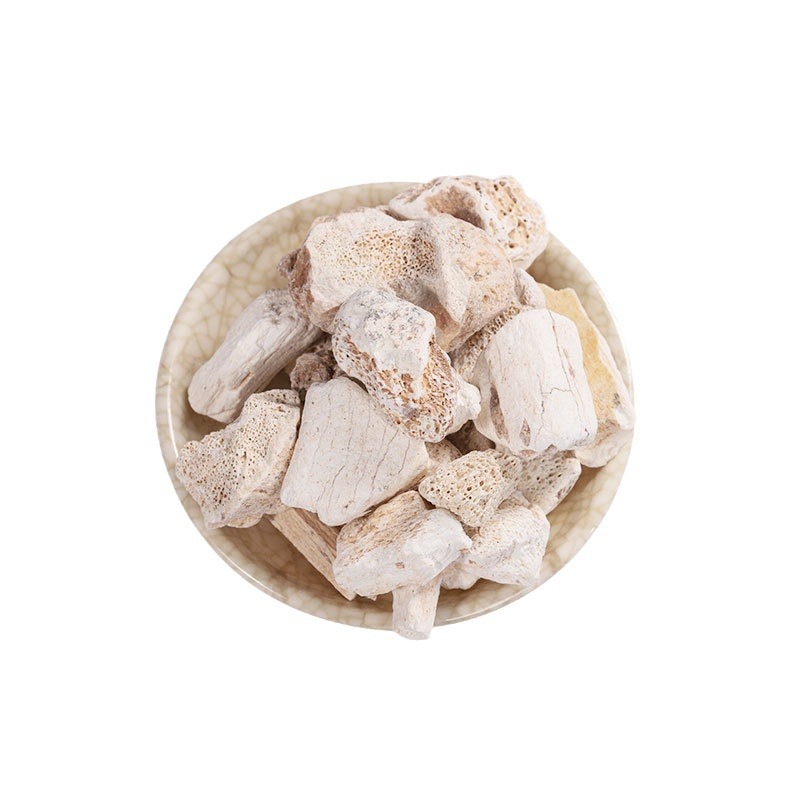
In the grid-like drawers of Chinese herbal pharmacies, one particular ingredient never fails to captivate the imagination—"dragon bone" (龙骨, lóng gǔ). Its name, steeped in myth, evokes images of skeletal remains from legendary dragons. These pale, stone-like fragments, transformed by healers into remedies for calming the mind and soothing fright, carry within them millennia of Chinese medical wisdom. Yet a deeper exploration of this extraordinary material reveals a journey that bridges myth and reality, connecting ancient beliefs with modern science. Dragon bone is not merely a staple of traditional medicine; it is a vivid testament to how our ancestors observed and harnessed nature’s secrets—many of which remain little-known today.The medicinal use of dragon bone dates back over 2,000 years to the Shennong Bencaojing (神农本草经), China’s earliest surviving pharmacopoeia, where it was classified as a "superior-grade herb" with properties described as "sweet and neutral," effective for ailments ranging from psychological distress to hemorrhages. By the Han Dynasty, the renowned physician Zhang Zhongjing incorporated it into his Guizhi Gancao Longgu Muli Tang (Cinnamon Twig, Licorice, Dragon Bone, and Oyster Shell Decoction)—a formula still prescribed today for palpitations and insomnia. The Xinxiu Bencao (新修本草) of the Tang Dynasty documented its origins: "Found in the valleys of Jin and along the cliffs of Mount Tai, gathered without seasonal restriction." Li Shizhen, the Ming Dynasty scholar, offered a poetic explanation in his Compendium of Materia Medica (本草纲目): "Dragon bone is not true bone, but the shed remains of dragons—divine creatures whose relics are beyond mortal reach." These records reflect not only early insights into its therapeutic properties but also the awe it inspired in ancient minds.
Modern science has demystified dragon bone: they are, in fact, fossils of prehistoric mammals—three-toed horses, rhinoceroses, and deer—that once roamed the lands of what is now northern China. Composed primarily of calcium phosphate and carbonate, these relics formed over millions of years during the Cenozoic era, buried deep within the loess soils of Shanxi, Shaanxi, and Gansu. In traditional processing, they are cleaned, broken into fragments, and sometimes calcined (roasted to a powder). Remarkably, ancient practitioners—devoid of modern geology—accurately identified its clinical value. Contemporary research confirms its rich mineral content, validating its historical use for sedation, anxiety relief, and astringent effects—a striking alignment of empirical wisdom and scientific validation.
In herbal formulations, dragon bone often plays a synergistic role. Paired with oyster shell, it enhances calming effects in the classic "Longgu Muli Tang." Combined with Polygala (远志) and Poria (茯苓), it addresses insomnia; with white peony root (白芍) and donkey-hide gelatin (阿胶), it helps manage abnormal bleeding. A curious tidbit: ancient physicians attributed its "soul-anchoring" power partly to its physical heft—the dense weight of fossils symbolizing stability. Folk remedies expanded its uses: powdered dragon bone mixed with vinegar treated wounds, while calcined powder blown into nostrils stopped nosebleeds. Some even hung fragments above cradles to ward off infant fright. Though not all applications are scientifically grounded, they reveal the creativity of traditional healing.
The lore surrounding dragon bone abounds with intriguing puzzles. Why did ancient texts prize "five-colored dragon bones"? Turns out, hues dictated therapeutic emphasis: white for calming, blue-green for shock, black for consolidation, red for bleeding, and yellow for sweating. Another riddle: how did "dragon teeth" (龙齿) differ? These were typically fossilized molars of herbivores, believed more potent for fright disorders. Most enigmatic of all—the 1987 discovery of a 8-million-year-old rhinoceros skull in Inner Mongolia, its horn reverently enshrined as a "true dragon horn" by locals before paleontologists identified it. Such mysteries highlight the nuanced lens through which pre-scientific cultures interpreted nature.
Beyond medicine, dragon bone held profound cultural weight. It was deemed a bridge to the spiritual—the Records of the Grand Historian (史记) tells how alchemist Luan Da convinced Emperor Wu of Han that it could summon immortals. Daoist texts included it in elixirs of immortality, believing it channeled cosmic energies. Villagers buried it under homes as protection against evil—a custom lingering in some regions. Most pivotally, its role in deciphering oracle bone script is often overlooked: in 1899, scholar Wang Yirong noticed strange carvings on "dragon bones" sold as medicine—unbeknownst to him, they were Shang Dynasty oracle inscriptions, revolutionizing the study of early Chinese writing. A serendipitous collision of pharmacy and archaeology.
Today, dragon bone straddles tradition and modernity. As paleontology advances, its dual identity as fossil and drug sparks debate. China’s 1995 Cultural Relics Protection Law safeguards scientifically significant specimens, pushing TCM to seek alternatives like calcined oyster shell or mother-of-pearl. Yet a 2013 study revealed its unique microcrystalline structure—forged over eons—hinting why ancients revered it above mundane minerals. This tension between preservation and practice deepens our appreciation for ancestral ingenuity.
From medicine jars to museum displays, dragon bone’s meaning evolves with human understanding. Once deemed mystical "dragon relics," these fossils now illuminate Earth’s deep history. As the Bencao Gangmu observed: "That which is divine in nature must hold divine purpose." Its duality reminds us that science and tradition need not clash—they can converse. With open curiosity, we honor the past while embracing discovery. In each fragment lies not just healing, but a chronicle of civilization—and an invitation to marvel at nature’s wonders, ancient and enduring.
Contact:
For market reports or sourcing inquiries:
Etan Zong
Email: Etan@bzjiahe.com
Website: www.bzjiahe.com







